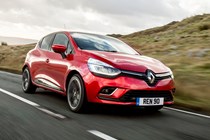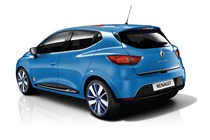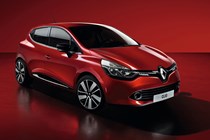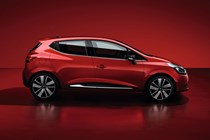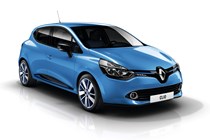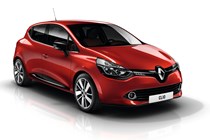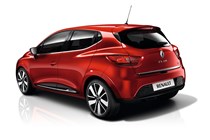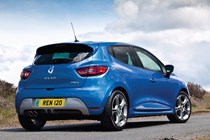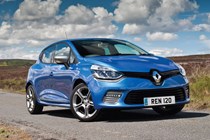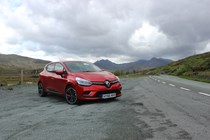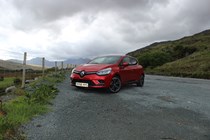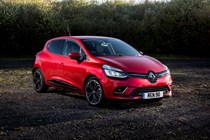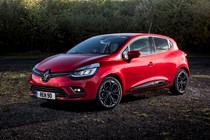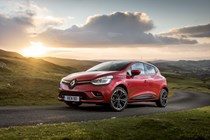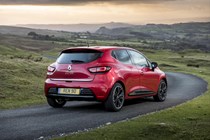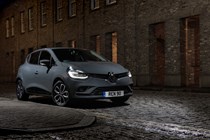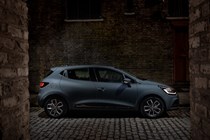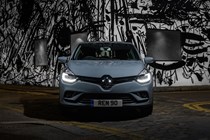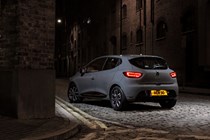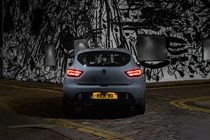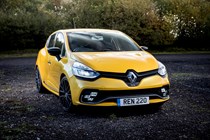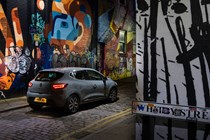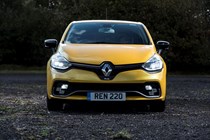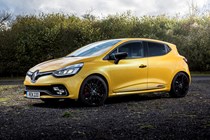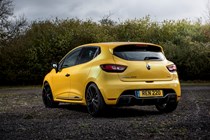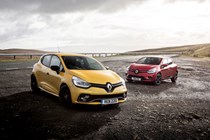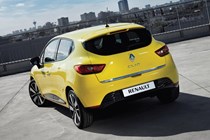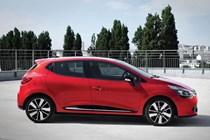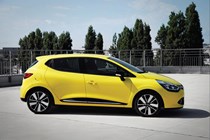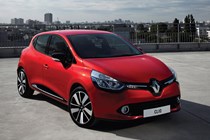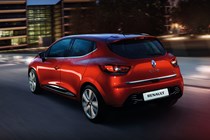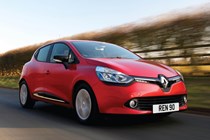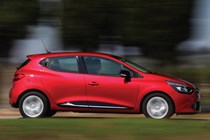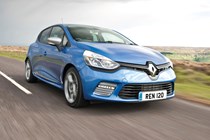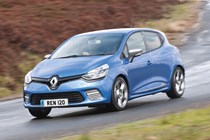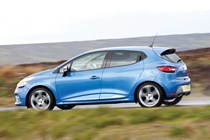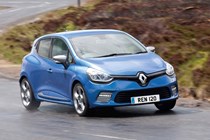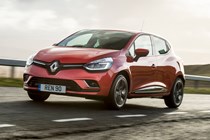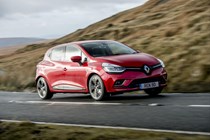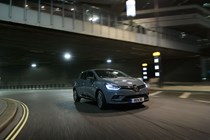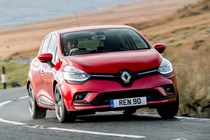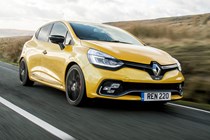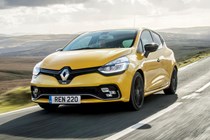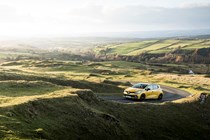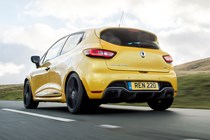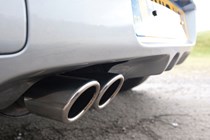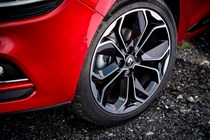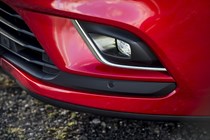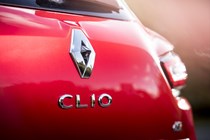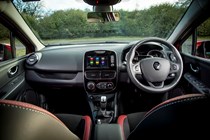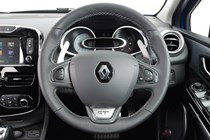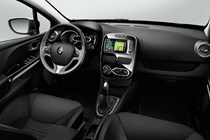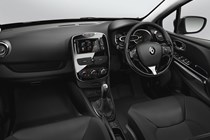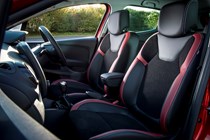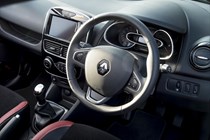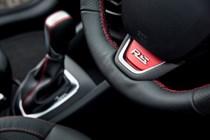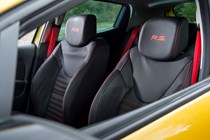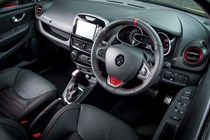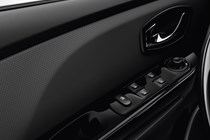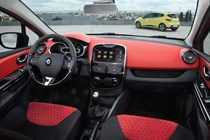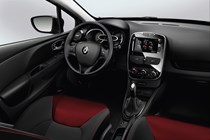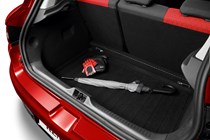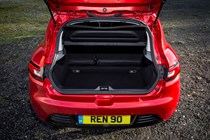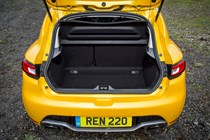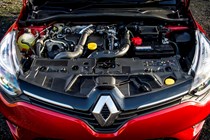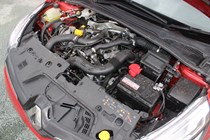
Renault Clio Hatchback (2012-2019) engines, drive and performance
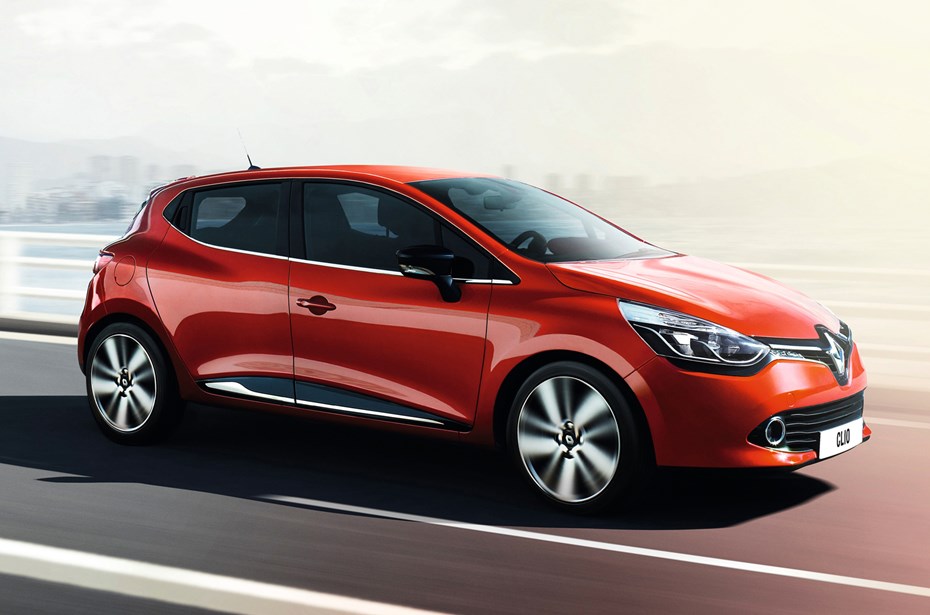
- Economy-focused petrols and diesels
- TCe 90 petrol is a decent all-rounder
- Renaultsport models hampered by gearbox
Petrol engines
When the Mk4 Renault Clio was launched, its opened off with an entry-level 1.2 16V 75 petrol engine, the only one referred to by its capacity in litres. Except it’s not: while Renault calls it a 1.2, it’s actually a 1.1.
As its name suggests, it develops a weedy 75hp, which is only enough for a top speed of 103mph. Torque isn’t especially high at 107Nm, which means you have to work the motor hard to get the best from it. Pulling power doesn’t peak until 4,250rpm, resulting in a pedestrian 0-62mph time of 14.5 seconds.
It’s not a very flexible engine and feels overwhelmed by the Clio’s size, so unless you really must have the least expensive choice, avoid it. A five-speed manual transmission is the only gearbox here.
Later, Renault introduced the Tce 75. This is a 0.9-litre three-cylinder petrol with 75hp and 120Nm of torque. It takes 12.3 seconds to get from 0-62mph, so this engine is much more at home in town than on the motorway. If it’s just you in the car around town most of the time, it’ll be fine.
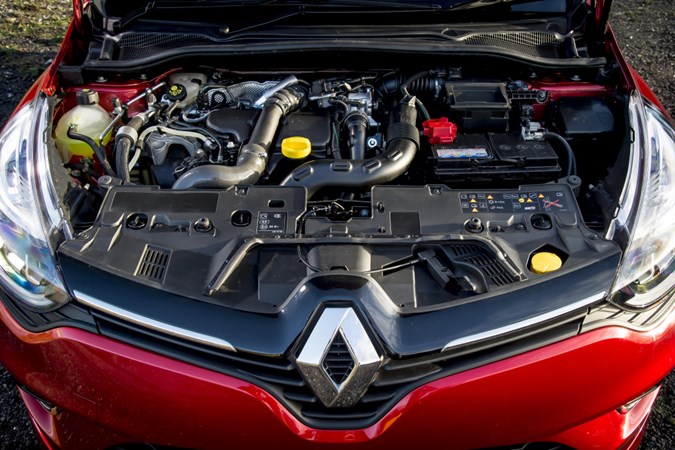
However, if you regularly carry passengers or venture away from urban areas, we recommend you hunt out the more gutsy TCe 90. It uses the same three-cylinder 0.9-litre unit, but with a boost in power and torque to 90hp and 135Nm respectively.
That 90hp output yields a 112mph top speed, while the 135Nm of torque from 2,500rpm makes the standard model reasonably flexible, requiring fewer gear changes on the five-speed manual when overtaking. It also trims the Clio’s 0-62mph time down to 12.1 seconds.
There was an eco version that was slightly torquier at 140Nm, but the fuel-saving measures hampered acceleration with the 0-62mph time being 0.9 seconds slower.
There was more gusto with the Energy TCe 120 that sat above the TCe 90 – this was a four-cylinder unit, but still small at 1.2-litres.
Whether you stick with the standard six-speed manual or the optional EDC dual-clutch automatic with the same number of ratios, the 120hp output means a 124mph top speed.
A useful hike in peak torque to 205Nm at 2,000rpm makes this unit even more flexible and it makes sense if you drive more frequently out of cities but don’t cover the high miles to necessitate a diesel. The manual completes the 0-62mph sprint in 9.0 seconds, the EDC in 9.2.
Diesel engines
The fourth-generation Clio was also available with two diesel engines. They were both based on the same turbocharged 1.5-litre four-cylinder engine – and, both featured start-stop technology for some added fuel efficiency.
The lesser powered version was called the Energy dCi 90 – and it was available in standard and Eco formats. A five-speed manual was the default transmission, with a six-speed EDC auto being an optional extra on the non-Eco model.
Power, unsurprisingly given its badge, is 90hp. That’s enough for a 112mph top speed on the manual versions, or 109mph for the EDC. Renault later trimmed the Clio’s diesel range down to just the regular dCi 90 (non Eco) model, though.
All versions produce a healthy 220Nm slew of torque from a low 1,750rpm, which sounds great. However, the long gearing means it’s skewed towards efficiency rather than out-and-out acceleration. The manual model has an 11.8-second 0-62mph time, the EDC taking longer at 13.1 seconds.
Renault also offered an Energy dCi 110 diesel which, as well as a 20hp increase over the dCi 90, also enjoyed a 40Nm boost in torque to 260Nm over its lower-powered stablemate. That bumped the car’s top speed up to 121mph and trimmed its 0-62mph time to 11.1 seconds.
You really notice the extra punch on offer compared with the 90hp version, with an eager yet smooth power delivery. It’s quite refined as well, and the sixth gear ensures it remains relaxed at motorway speeds.
You will need to make decent use of the six-speed manual gearbox though. The car’s eco focus means it likes to sit in higher gears to reduce fuel consumption, but if you demand a sudden burst of power, you’ll need to change down a gear or two.
Performance engines
At the top of the Mk4 Clio range is the Renaultsport Clio. There were two versions available when the car was new – the standard car was badged Renaultsport 200 but there was also a more hardcore Renaultsport 220 Trophy – and both were powered by a turbocharged 1.6-litre petrol engine.
This hot Clio wasn’t as well received as previous hot Clios. Enthusiasts (us included) couldn’t find anything wrong with its engine, but they hate its dim-witted six-speed EDC dual-clutch automatic gearbox. There also wasn’t a manual alternative, despite Renault teasing one in concept form. At least the Trophy’s transmission is more responsive with quicker changes.
With maximum pulling power of 240Nm for the 200 – and up to 280Nm in fourth and fifth gears for the 220 Trophy – from 2,000rpm, it’s a flexible and refined unit. Don’t let the pops and burbles on downshifts fool you, it’s not as visceral as its predecessor.
Flat out, the 200 will reach 143mph, while the 220 Trophy is slightly faster at 146mph. Acceleration is also rapid: the 0-62mph sprint takes 6.7 seconds in the 200, 6.6 seconds for the Trophy.
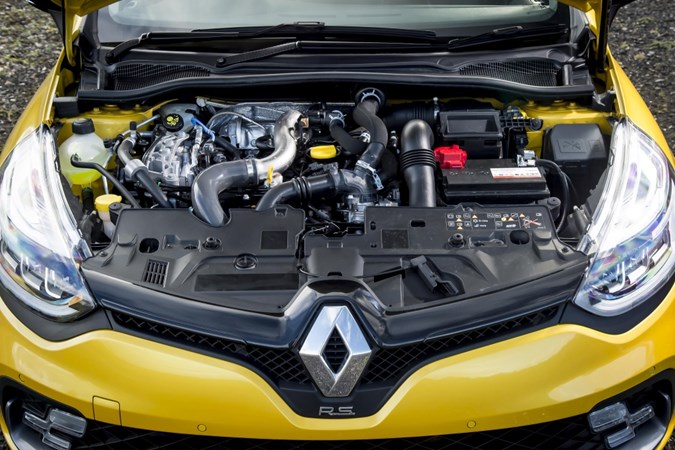
There are also three driving modes to play with: Normal, Sport and Race. Normal is the default setting and in this mode the Clio Renaultsports are easy to drive.
Switch to the Sport mode and they become feistier. The acceleration is optimised, as are the gear shifts, while any wheel spin is controlled by the traction control.
Race mode is best used on track days: when you toggle the Renaultsport button to get this mode the traction control is disconnected while gear-shifts are entirely manually-operated, using the paddle shifters behind the steering wheel.
Renault Clio models we’ve tested
Iconic TCe 90 (Tested March 2019 by Lawrence Cheung)
![]()
As this generation Clio heads towards retirement, the TCe 90 is the most powerful petrol engine you can have in the range before heading on to the high-performing Renaultsport model.
The 0-62mph time of 12.1 seconds doesn’t scream excitement on paper, but it’s certainly eager enough for everyday use. The old-fashioned power delivery means you’ll have to work the engine harder to get going and may be an acquired taste depending on what you are used to, though.
This turbocharged engine does feel quick for its size, but it needs waking up above 3,500rpm before it gets into its stride, when it delivers its power in one lump.
This can make every day driving fun as it makes the car feel quicker than it is, but if you are used to a naturally-aspirated engine and its smoother power delivery, this might feel a bit uncouth. The Clio’s turbocharged rivals provide a more refined experience.
Ideally, if you mostly dwell around town and at low speeds, you’d want the power to be more accessible lower down in the rev range, otherwise if you try to drive in a hurry it’ll make for jerky progress. Plus, the five-speed gearbox isn’t the slickest to use, meaning this whole experience is starting to feel quite agricultural.
Renault Clio Dynamique Nav dCi 90 Eco
(Tested: May 2016)
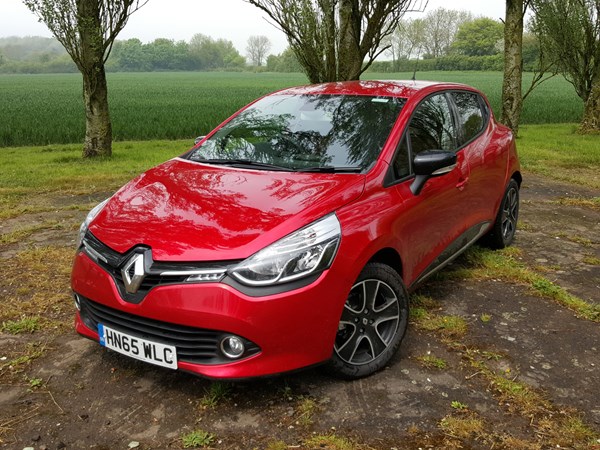
In standard form this engine produces 85g/km of CO2 and promises 86mpg, but if you pay an extra £250 you can have the frugal Eco version, like our test car. This features a special Eco switch in the car that dulls throttle response in order to reduce fuel consumption.
As a result, it promises a slightly improved 82g/km and 88mpg. It’s ok on the motorway but makes the Clio feel a bit leaden everywhere else. Those are not the most significant savings so we think it’ll take a while to recoup your £250. Company car driver? In 2016, it would cost you £49 a month in BIK tax, rather than £48.
There’s a woolly feel about this Clio’s pedals and gearshift where we’d like a more positive feel, and while this version is lighter than its predecessor, it still feels like a big car. That said, it’s still extremely good fun, particularly with this punchy diesel engine, which develops 90hp and 220Nm.
That last figure makes the Clio feel lively in the middle part of the rev range. You only get five gears but the engine is quiet on the motorway, in part because there’s quite a bit of wind noise from the door mirrors drowning it out.
We’re not convinced by the £250 Eco upgrade though. We spent our time in the Clio with the button firmly in the off mode, and even with it on, it’ll take a long time to recoup the up-front cost.
Renault Clio Renaultsport Lux
(Tested: November 2013)
While the previous Renaultsport Clio boasted a naturally aspirated engine endowed with a turbo-like thrust, the new car uses forced induction to create a linear power delivery not unlike the larger endowed RenaultSport Megane. In a straight line it doesn’t feel as fast as the figures (0-62mph takes only 6.7 seconds) suggest, but that’s mainly down to the automatic gearbox.
The six ratios are too widely spaced and the long gearing feels at odds with this car’s frenetic purpose. Selecting Sport or Race mode does little to help – it simply holds the ratios for far too long – but knocking the lever into manual does help.
Swapping cogs via the steering column-mounted paddles helps, but we wish they were either longer or pivoted with the wheel as reaching for the next ratio while cornering often results in fumbling fingers and a nudged rev-limiter.
Minor disappointments about the drivetrain aside, the RenaultSport Clio’s chassis is fantastic, and any apparent lack of pace or power disappears at the first corner. The steering could do with a little more feel, but grip is strong and reactions are razor sharp.
Enthusiastic drivers, with the safety aids switched off, can back off the throttle mid bend to entice the rear end into play as it swings around to tighten the corner. Easily controllable, this throttle adjustability is a real highlight, and the harder you drive this car the more it rewards.
There’s absolutely no doubt that this new RenaultSport Clio is softer and more grown up than before, and it’s because rather than in spite of this that the overall package is better. The automatic gearbox won’t suit all, but the engine is willing and the chassis a belter.
However we can’t recommend it in expensive Lux form; the cheaper and just as talented base model with Cup chassis option is the best bet. Provided you ignore the more involving, and cheaper, Ford Fiesta ST that is.
Renault Clio RS Trophy
(Tested: December 2015)
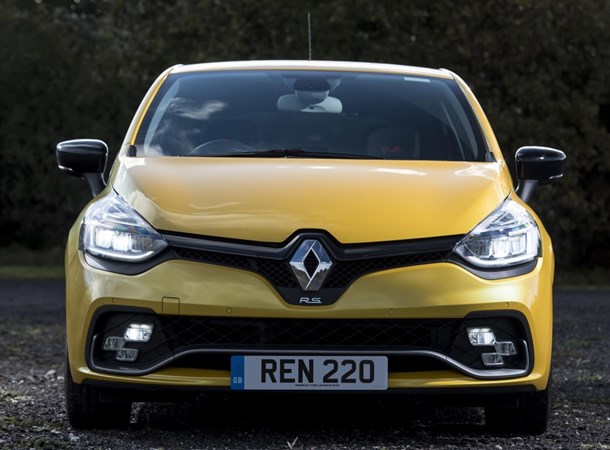
The car we’re driving here, the Renaultsport Clio 220 Trophy EDC, is easily the most focused of the whole bunch. And so it should be, because the firm makes a lot of noise about borrowing technical nous from its ventures in Formula 1.
The result? Thanks to heavy revisions to the paddleshift gearbox, and ditto the engine, plus some choice chassis modification, we think this new flagship Clio is the quickest and most exciting car of its size.
Enthusiasts might wonder how that could be, since it’s the only car in the sector which uses an automatic gearbox, so naturally it’s easy to assume it’ll be less involving. Certainly the firm’s first attempt lacked the engagement required for great fun on UK roads. Critics simply enjoyed rivals’ manual ‘boxes more.
The steering has been modified for faster and more precise response, and we firmly believe it’s the most communicative system we’ve tried on cars of this type; if not on any hot hatch. A ride height 20mm lower over the nose and 10mm at the rear means the front end has even more bite, so the R.S. differential can perform its lateral torque-shuffling more effectively and thus corner exit speeds are improved. The rear end feels fractionally more playful too, which allows more adjustability when cornering quickly.
Its springs and dampers are stiffer than before, which is at the expense of a little ride quality, but actually it’s better than you might imagine. Only the tallest, sharpest speed bumps cause an uncomfortable jolt through the car, but this thing will go around a bend like you wouldn’t believe. The quicker you go, the better the chassis seems to become.
The rev limit has been raised to 6,800rpm, offering another 300rpm over the standard Renaultsport Clio, which means downshifts are available earlier, further amplifying this car’s performance pedigree because it allows you to concentrate more on braking and steering when entering a bend.
To make the most of all this extra performance, you’ll want to flick the RS Drive control into Race mode. This switches the engine configuration, throttle mapping, audible gearshift indicator and steering into their hardest settings, and also carries out two other interesting functions.
A launch control function is installed too, which means the Clio takes off as quickly as it can by the car selecting and holding the perfect revs for optimum acceleration.
It pins you back into the beautiful optional heated leather sports seats installed in our test car. These cost another £1,600, which is a lot of cash relative to the £21,780 list price of the standard 220 Trophy, but we’d probably pick them given the choice.
This is a car that needs to be driven very hard to be fully appreciated, so the cheaper Fiesta ST or 208 GTI by Peugeot Sport are still hard to ignore as daily drivers. We’d have to say a non-Trophy 200 would be our pick of the Clio range in those circumstances too.
However, if outright performance, modern technology or even visits to the race track are high on your list of priorities, the Renaultsport Clio 220 Trophy is all the supermini you’ll ever need.
- Enjoyable handling a Clio hallmark
- Pity the steering’s so uninvolving
- Renaultsport Trophy feels much improved

This fourth-generation Renault Clio is longer, wider and lighter (to the tune of 100kg) compared with its predecessor, resulting in a positive effect on handling, as well as reducing fuel consumption.
Body roll is well-controlled making the Clio an enjoyable tool for exploiting winding roads. Traction when turning into bends is impressive, so much so it heads towards the hallowed Ford Fiesta for everyday driver enjoyment.
It’s not the last word in fun, however, and that’s down to the steering. Although direct, the steering could do with having more weight and less of an artificial feeling to sate keener drivers. However, this set-up should prove to be a winner when driving in crowded city centres and will make parking easier.
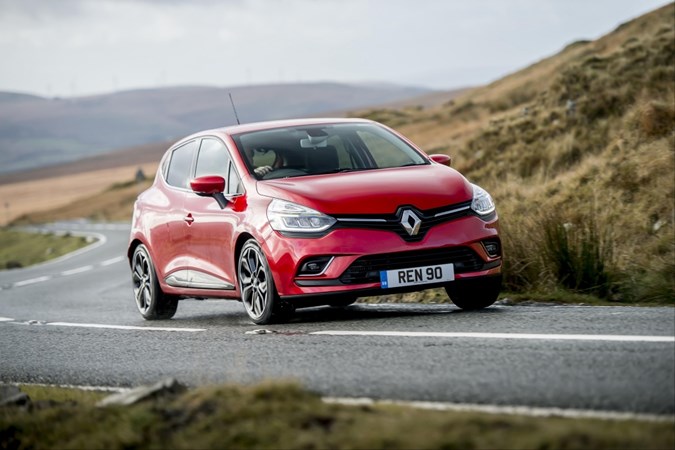
Clio Renaultsport is a sharper proposition
Changes have been made to the Renaultsport Clios to deliver more fun than their lesser siblings, but the lack of feedback through the steering remains. That’s a great shame, because you never get the same amount of confidence from the car when comparing with the hot Clio’s predecessor.
It’s a direct enough set-up, but it’s frustratingly light.
Go for the lower, stiffer Trophy version and while it doesn’t feel as raw as its third-generation Clio equivalent, it is better-honed for enthusiastic drivers.
Further modifications to the steering rack see it respond quicker and, along with Michelin Pilot Super Sport tyres fitted as standard, it’s a significantly more engaging proposition. Albeit one lacking the involvement of a conventional manual gearbox.



